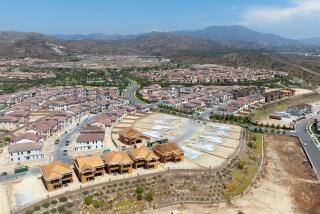Irvine’s Road Test : Experiment with narrow streets is promising
For some folks the ideal may be broad boulevards with towering trees overhead, streets so wide they seem to take forever to cross.
That’s not what they have in mind in Irvine.
There, in one of America’s best-known planned cities, the streets in the newer communities are narrower, not wider. The purpose is to make the communities more tightly knit and attractive. Narrower roads also can be safer because they force motorists to slow down.
The new slim-street design is being tried elsewhere in Southern California as well: Palm Springs and San Clemente, to name just two communities. It’s an experiment worth trying. Fostering a sense of community deserves applause, especially where suburbs and shopping malls have spread things out and created an impersonal environment.
There have been urban planners as long as there have been cities. But as the shape of downtown has changed in cities across America and as the suburbs crept ever outward, designers have tried different methods to please residents, shoppers and tourists.
Los Angeles has spent more than $14 million in an effort to transform Pershing Square from a park known mostly for derelicts and drug dealers to an inviting oasis among downtown office buildings and hotels. Those who live and work near the park agree that the park’s appearance has improved. But they point to design flaws that have impeded even greater success.
Critics say the perimeter walls have increased the sense that the park is isolated among the bricks and concrete of high-rises. To discourage camping by the homeless, the park has no bathrooms and only a small lawn. That deters families with children as well as casual passersby who might otherwise spend some time in the park.
Most of Pershing Square basically is an underground garage. Because of that, deep-rooted trees won’t grow, so the square lacks shade that draws people to other gathering spots on a hot day.
City planners, designers and architects continually try to solve such problems.
In Irvine, the curving streets in the newer communities are 30% narrower than the standard road in residential areas, which is 36 feet wide.
While narrow streets force drivers to slow down, they can also create problems for drivers of big vehicles, such as garbage and fire trucks. That’s why planners need to show their designs to various agencies and accept their input.
The Orange County Fire Authority joins cities in reviewing development plans. It has rejected several street designs in the county and approved others only after builders agreed to put extra fire hydrants in the area. That sort of joint planning can produce benefits for everyone, giving new residents the feeling of a cozier neighborhood but ensuring that safety is not sacrificed.
Planners say that besides narrow streets the trend has been to plant more grass and shrubs on strips along sidewalks, producing more color. San Clemente’s community development director, Jim Holloway, said too many areas “have more asphalt than we would like.” New developments tend toward “less pavement and more colors and vegetation along streets.”
The new development of Glenneyre at Lanesend in Irvine has a narrow road surrounded with strips of grass. That breaks up what otherwise could be a drab look. Underneath the grass is hard plastic, providing a tough surface in case vehicles such as fire engines have to roll over the lawn to respond to an emergency.
The experimentation in new developments in the county is an encouraging sign that builders and planners are not trapped in the status quo. Designs that don’t work well can be examples of what to avoid. Those that do work can be replicated elsewhere to benefit other residents.
More to Read
Sign up for Essential California
The most important California stories and recommendations in your inbox every morning.
You may occasionally receive promotional content from the Los Angeles Times.










